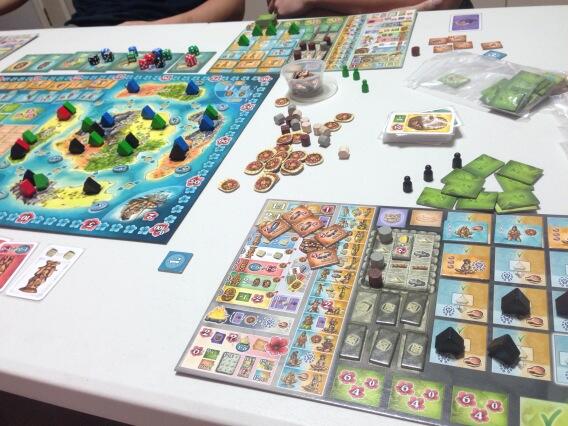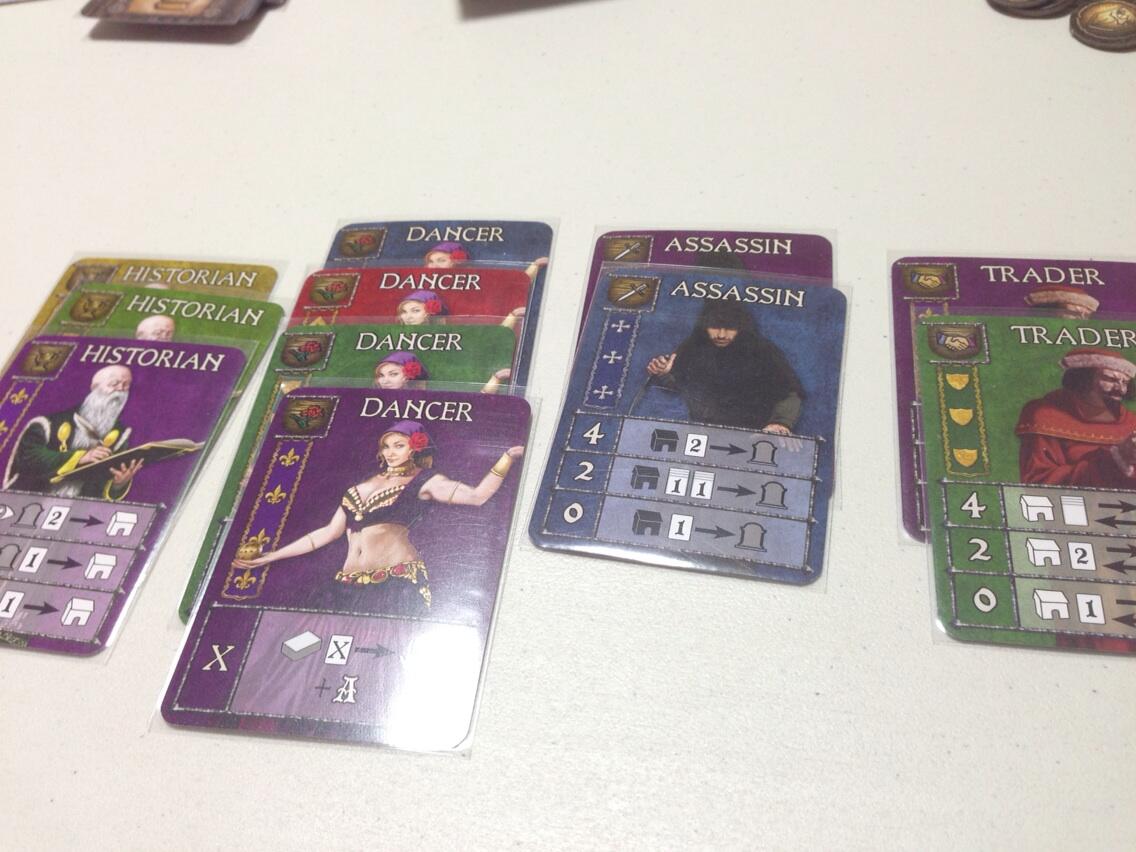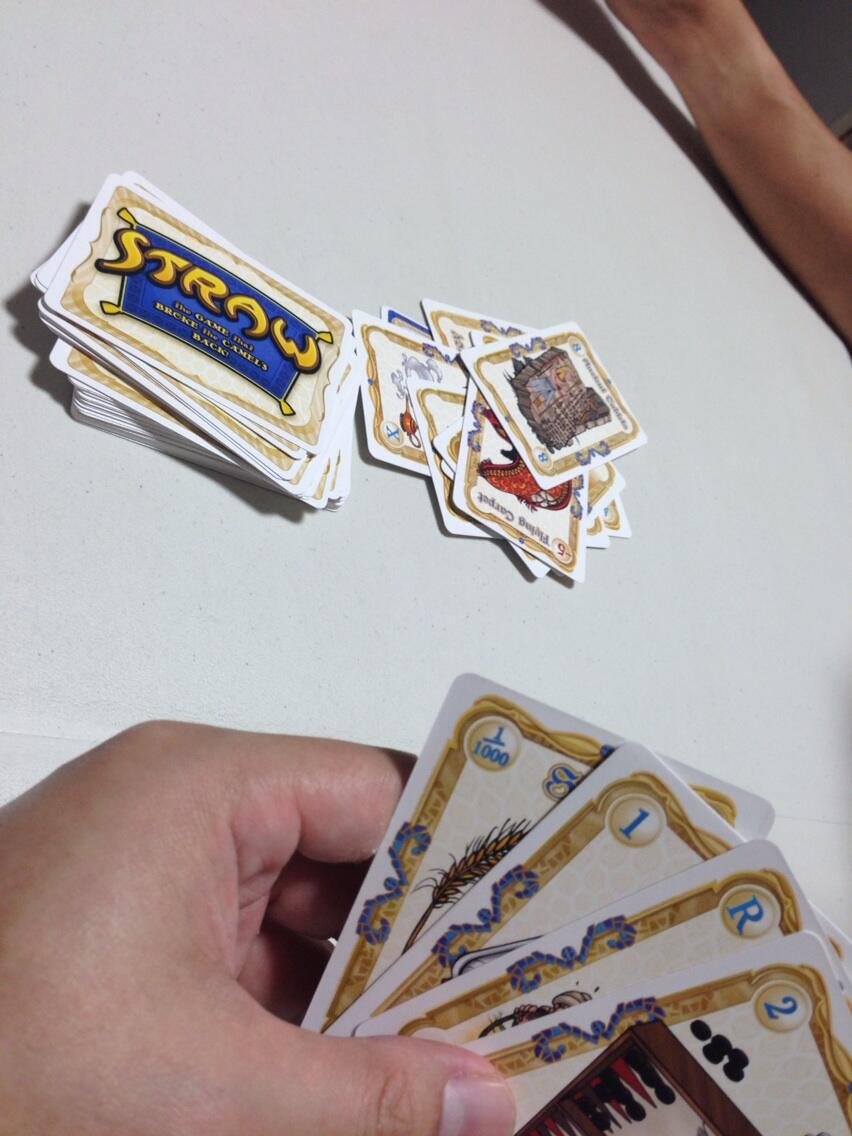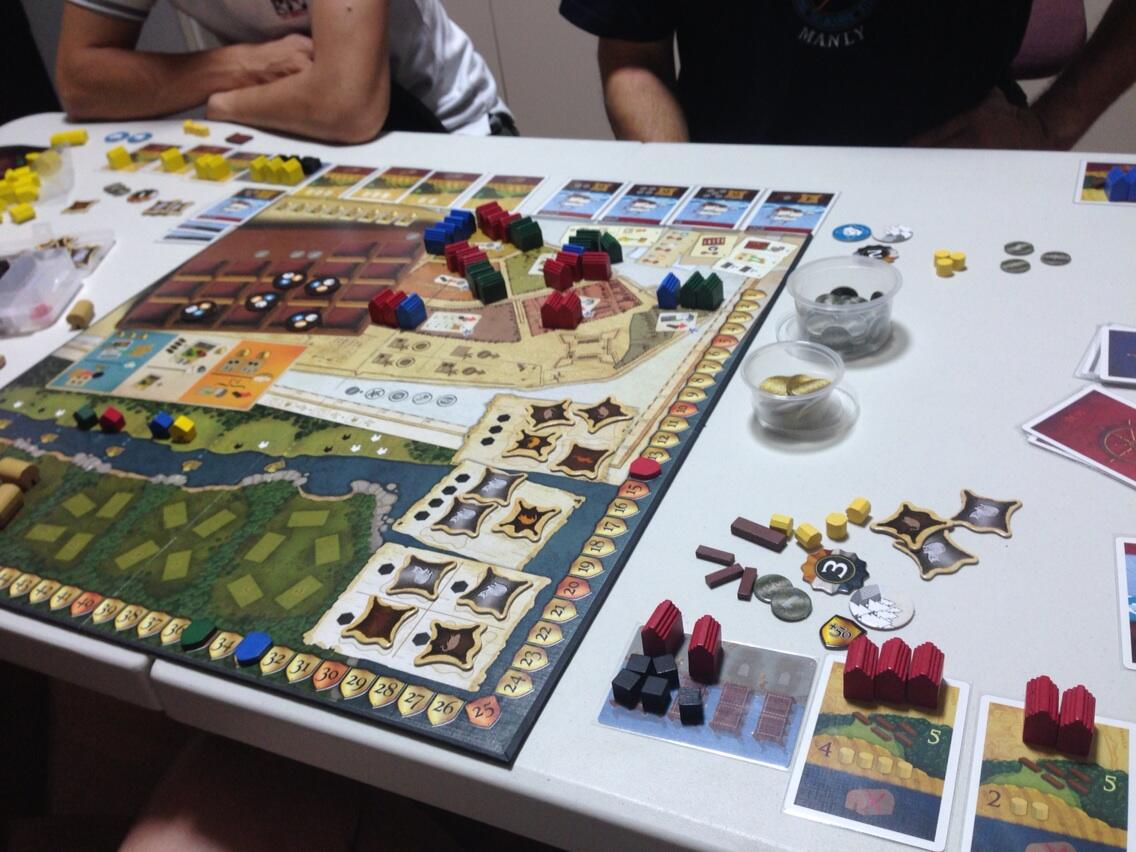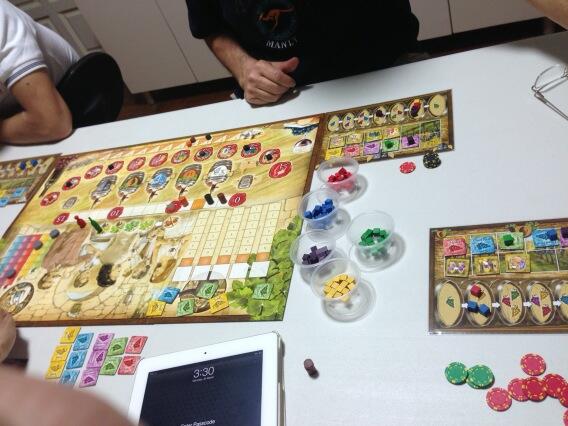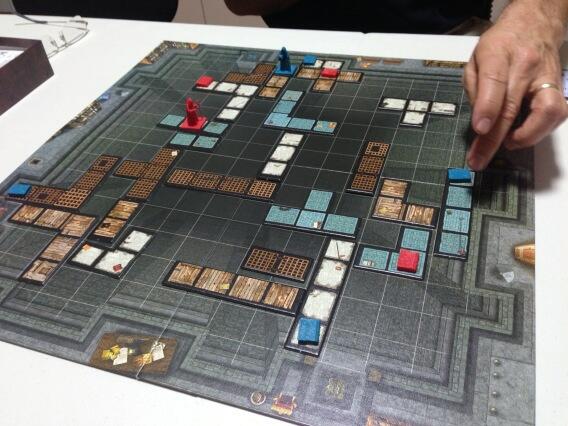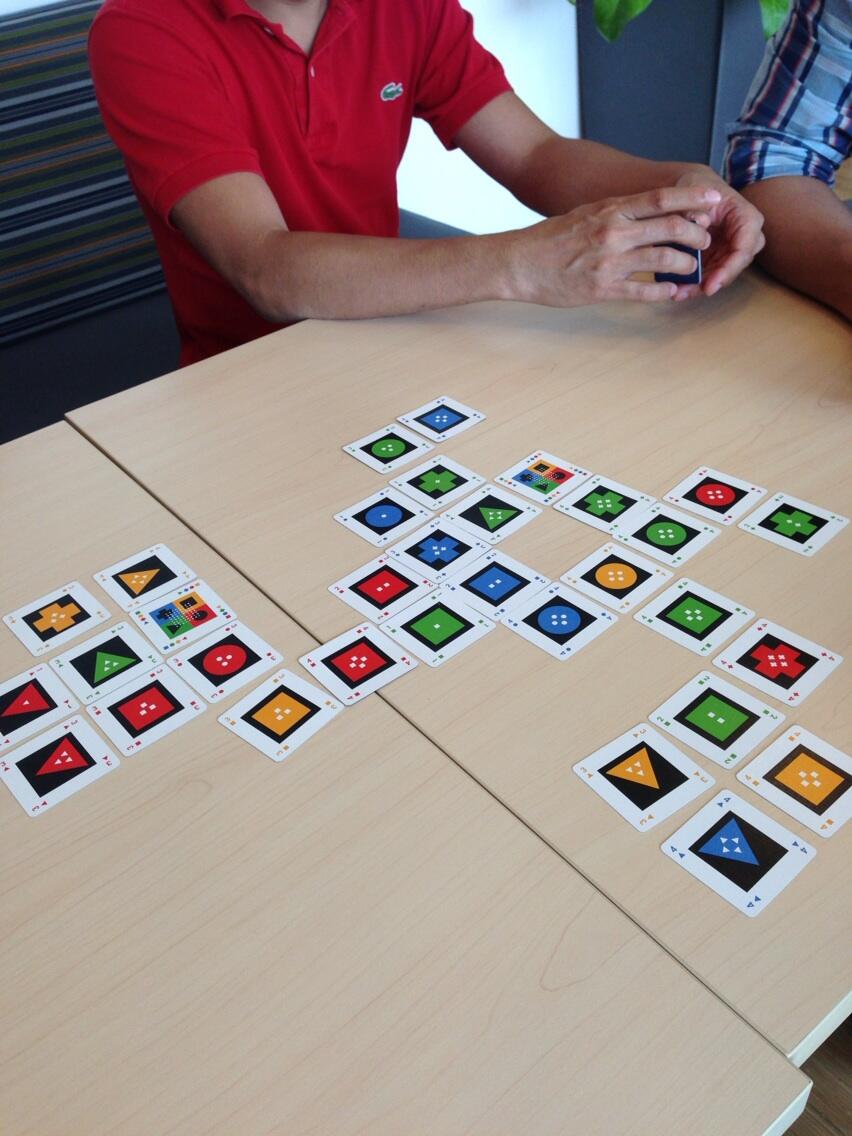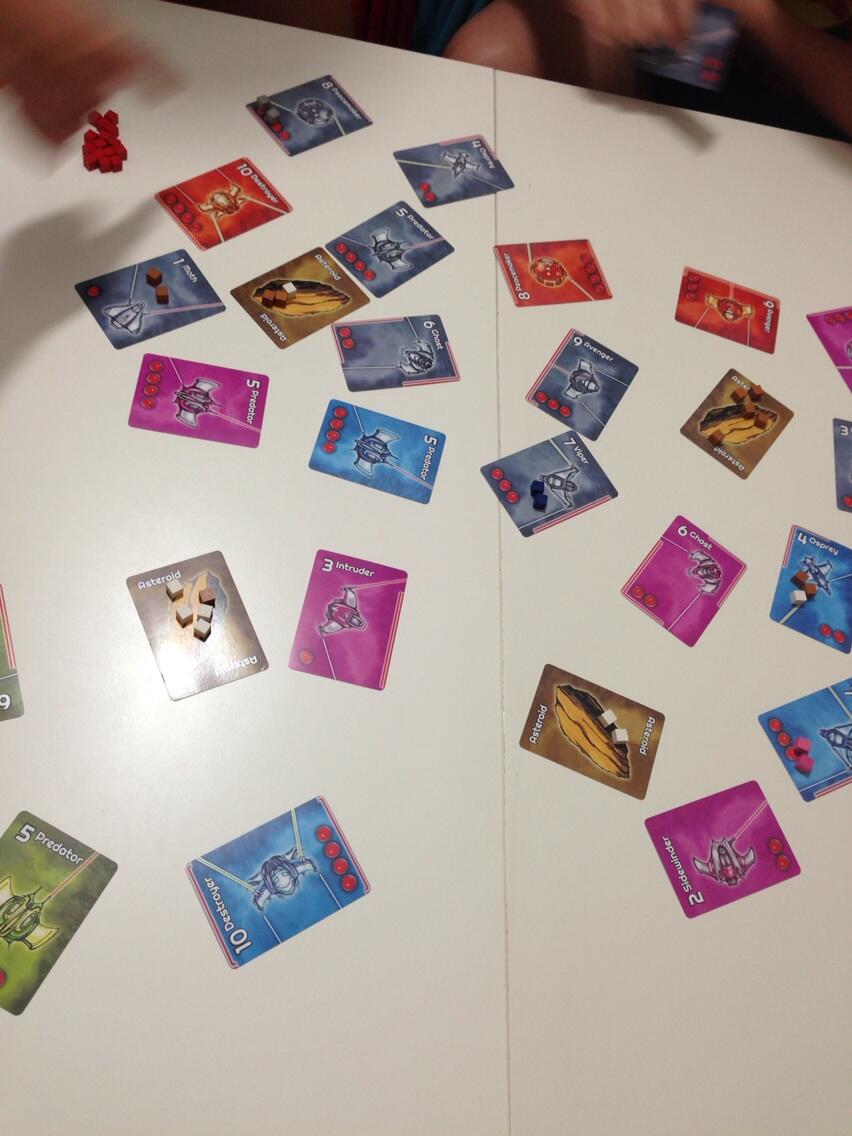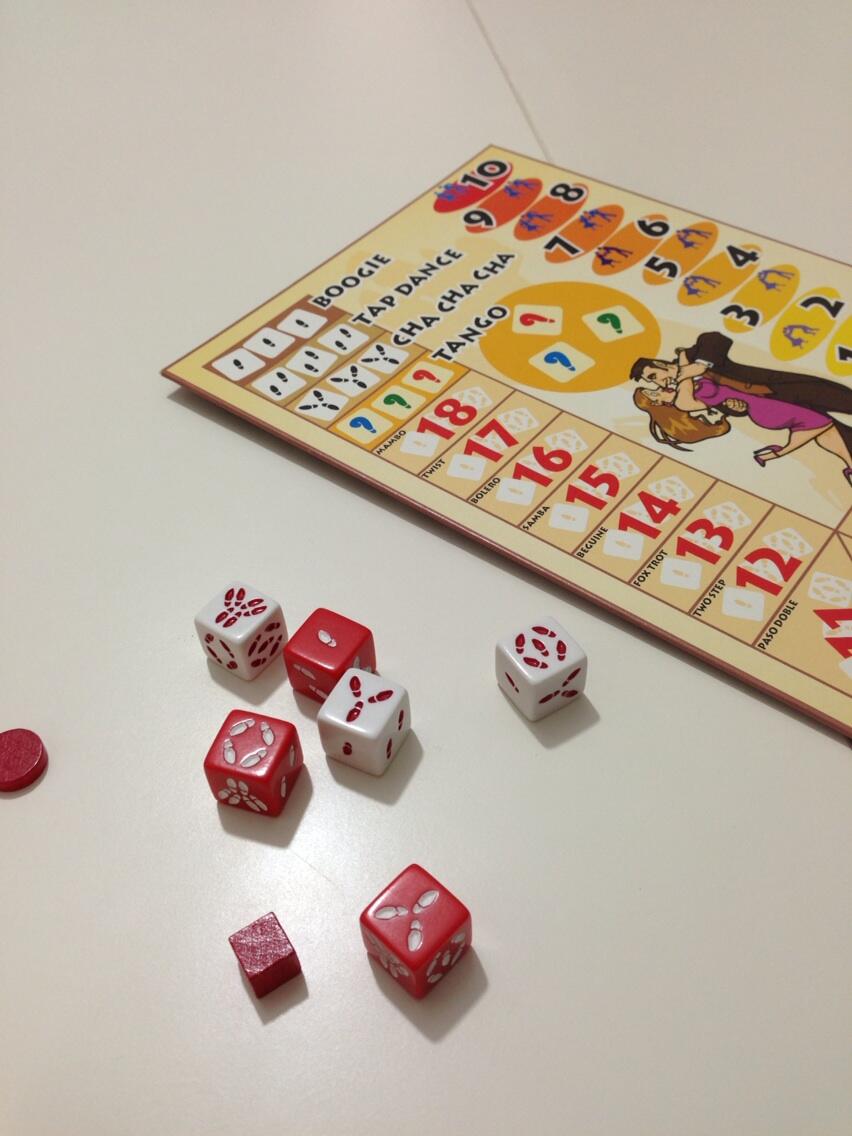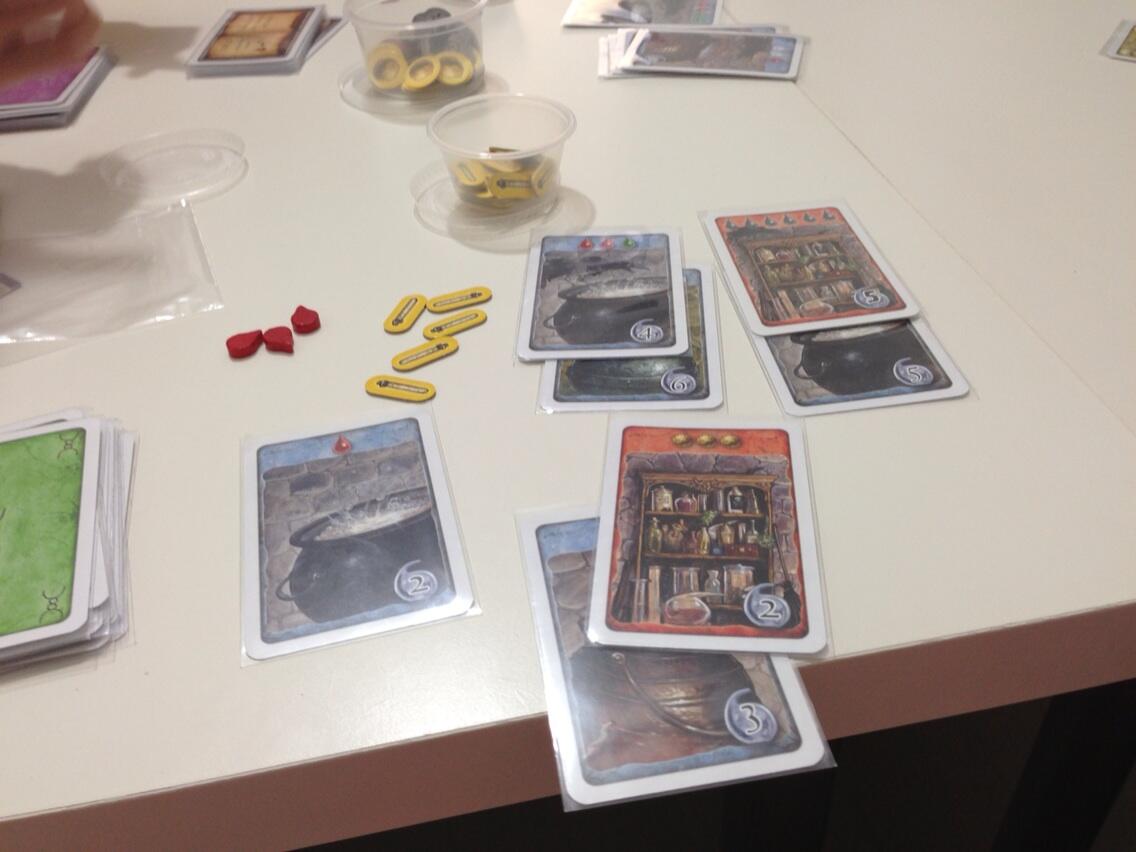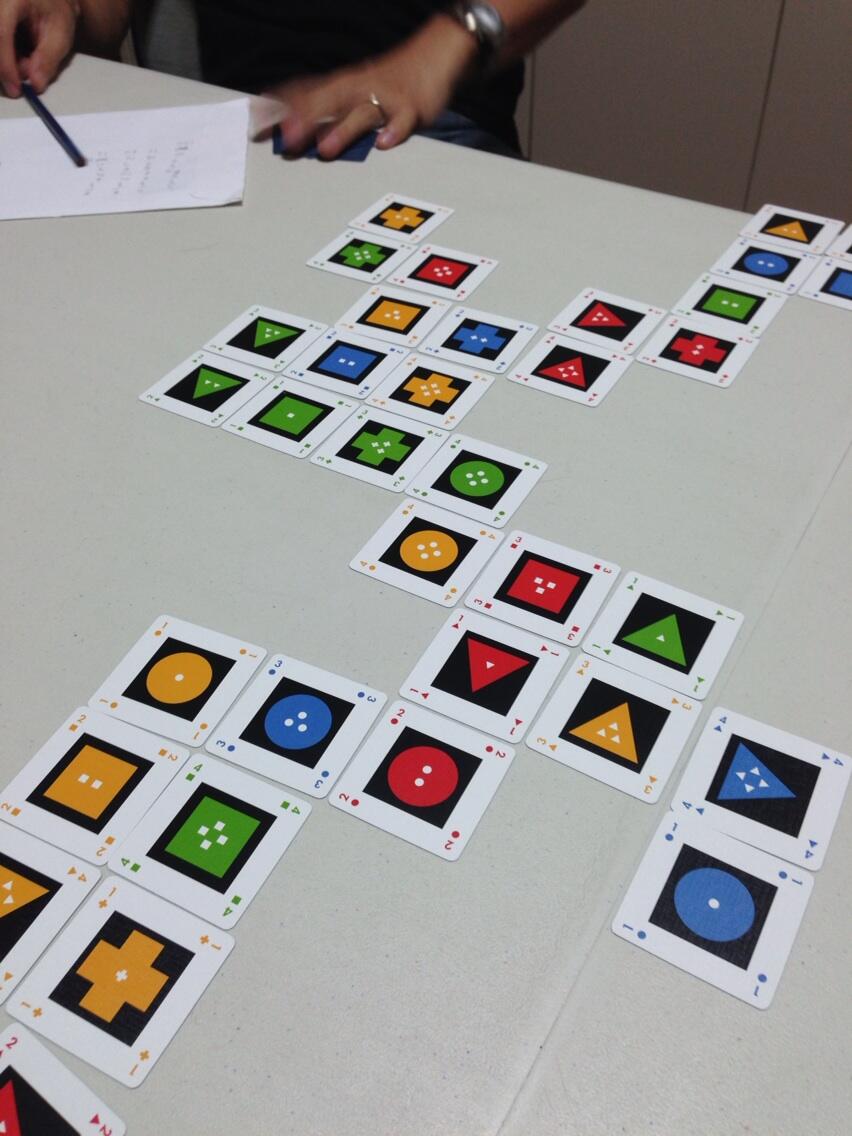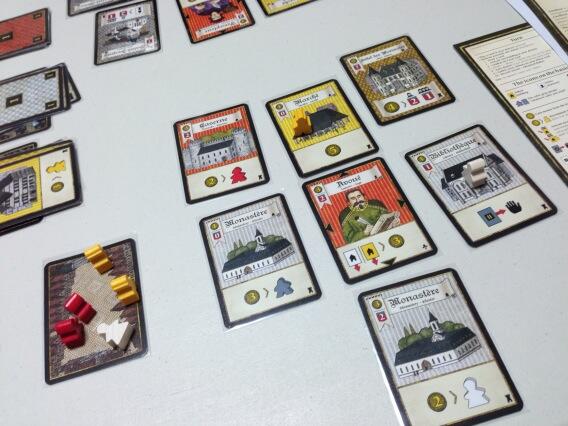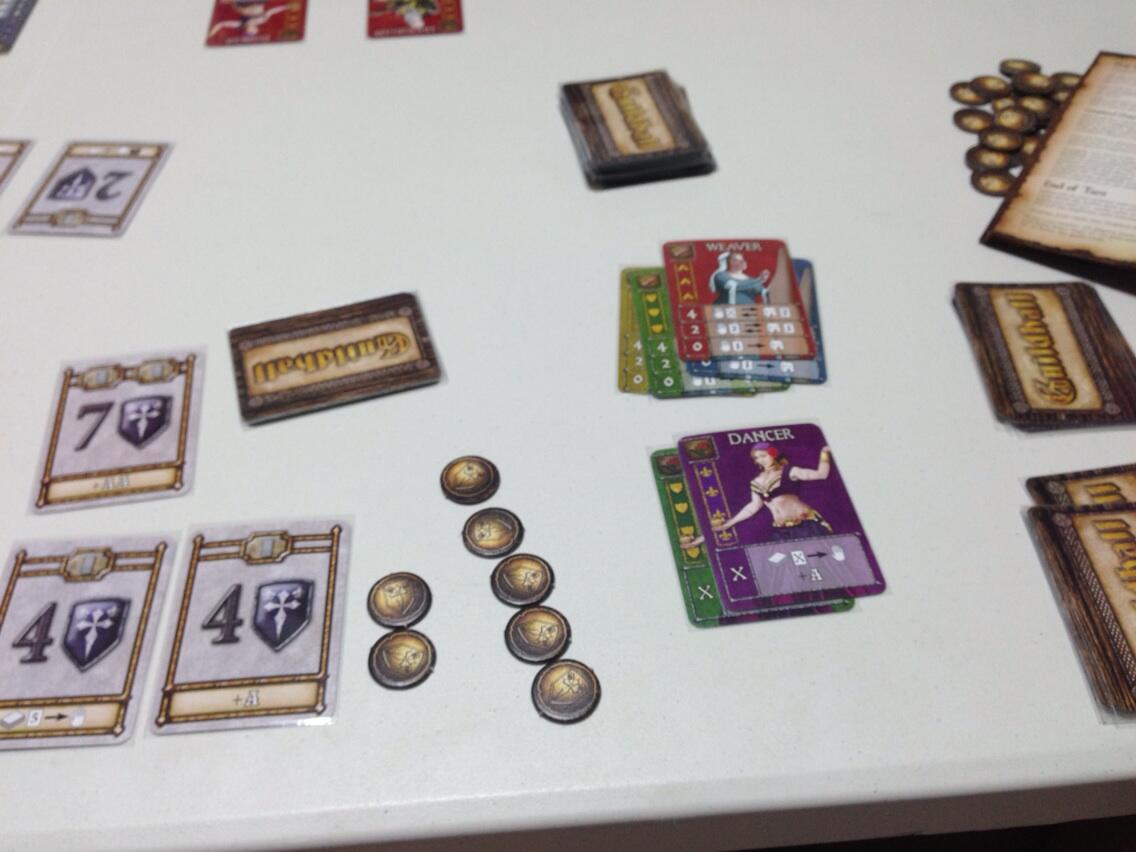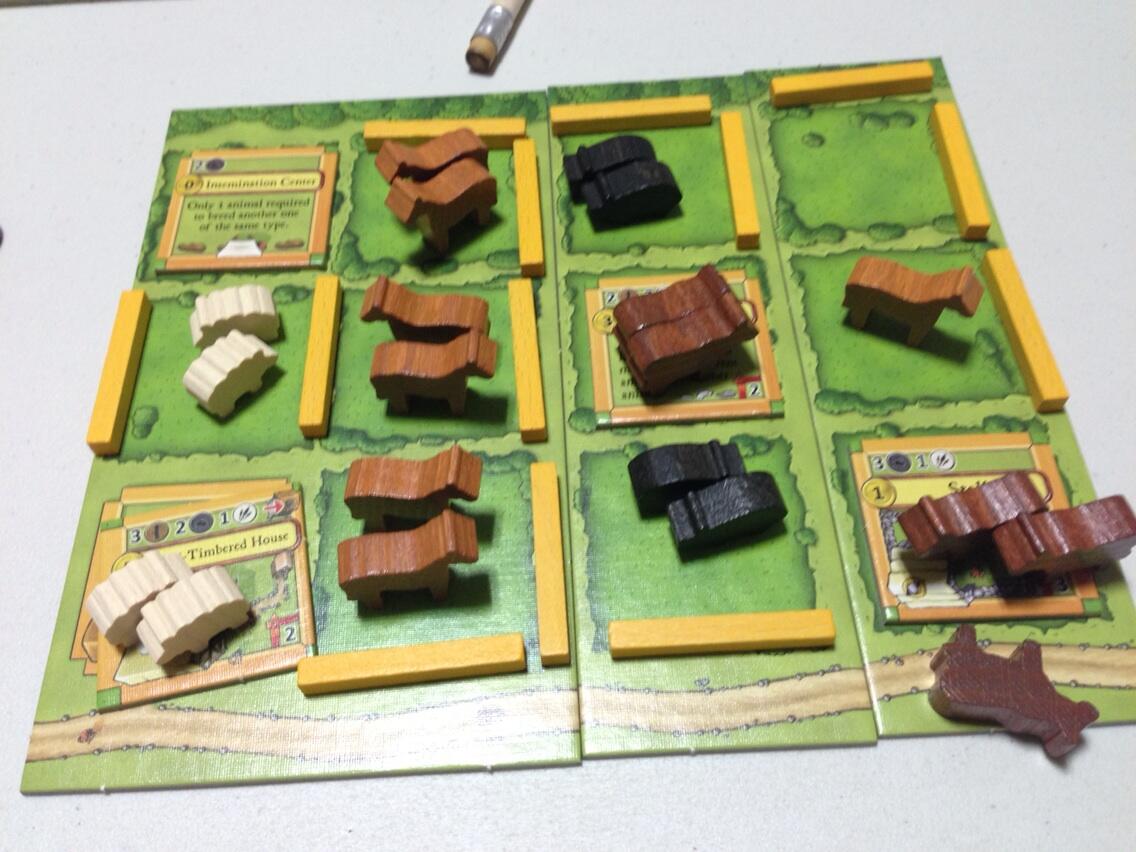Highlight for me this week is Nieuw Amsterdam. Its a new game for me and pretty fun to play!
Lets see what exciting games I have played this week :)
Bora Bora
Game Session and Thoughts: Manage to bring this out again and with more plays, I am getting better at managing what I want and the objectives I can accomplish. For most of the games so far I will attempt to complete all 9 objectives but that kinda dictates what I will be doing as my entire game is to try to get the various requirements done to achieve my objectives. I also managed to buy 6 pieces of jewellery and quite high scoring ones to get quite a few points. I was attempting to get the max points for tattoo by activating all my men tiles at the same time but only managed to get halfway. I have been listening to Joel and Lance's podcast and they talked about bora bora as well and what Joel said is pretty true. If during the game you find yourself in the lead most of the time, it means that you maybe doing something wrong or not maximising what you can do during the game.
So far I have not seen anyone manage to place all 12 huts onto the board OR fill up with 12 man/woman tiles. I think that is one of the more difficult ones to achieve for end game scoring. It seems the "filling of the 12 spaces" as well as building 6 of the tiles onto those 12 spaces are the best objectives to obtain since its possible to achieve both end game objectives at the same time, scoring you 12 points. Second easiest will be the jewellery but that is dependant on how the setup was like. Third will be the objectives and that is quite lucrative too because if you manage to complete 9 objectives you will at least have 4x9 = 36 points but you could have 6 x 9 = 54 points.
Pet Peeves: One kinda irritating thing I have found about this game is that setup is rather tedious. I will recommend having a bag each for the objectives, man and woman tiles. This will allow setup to be pretty fast as you don't need to sort them out. Another smaller peeve is that explaining how the game works can be quite lengthy because of all the different actions available as well as Phase B sections and the end game scoring. It will require multiple plays because most new players probably won't remember what the end game scorings are until halfway through the game which will not afford them enough time to switch plans halfway and switching goals halfway in the game can be quite detrimental. Jon pointed out the issue where the game seems to dictate what you can do because of the decreasing points in latter rounds for building and increasing points for the number of priests that you have. I can understand his point of view because I also box myself in by going after the objectives and thus determine what i need to and can do to get the points. Still I guess it makes it easier to let new players understand the game and get into it and give them a fighting chance against experienced players.
Conclusion: Still highly recommended from me.
Guildhall
Game Session and Thoughts: So after last week's playing 2 player I manage to play this with 3 and 4 and I must say 3 players is probably the sweet spot for this. It gives you an extra opponent to guard against and attack and doesn't extend the game play time for too long. Also gives an opportunity to guard against the leader. 4 may cause the game to take too long to finish. Surprisingly as you play the game, even though there maybe an early leader, usually every player will start to guard and disturb the leader such that the rest can catch up. This leads to very tense and exciting last few rounds as players try to win it themselves.
Pet Peeves: Unfortunately though, usually in the last round it is a forgone conclusion who will win and probably there is nothing else for the other players to do unless the luck of the draw allows someone else to catch up. Definitely recommends it with 3 or 4 but not so with 2.
Conclusion: Still a Try before you buy. Jon hates the art lol and will want to retheme it. Suggestions anyone?
Straw
Game Session and Thoughts: Straw is a light filler card game very similar to Zeus on the Loose. In the game, players are playing cards which represent goods with a certain weight/number. If the sum of all the cards on the camel (first card in the centre of the table) exceeds 50, then that player has "broken the camel's back" and all other players will score the cards in their hand for points. However there is a special card that is the Straw which if you use it to break the camel's back (i.e when it comes to you and the sum is 50, you play that card), then only you will score points. Game lasts as many rounds as there are players and the player with the most total points will win the game. Its very similar to zeus on the loose in that you are playing cards with numbers and having a sum total that you are trying not to exceed (in this game) and trying to exceed (in Zeus on the loose). In Straw, there are only a few "special powers" like reserve play order and the magic carpets which provide negative points. For Zeus, there are god cards with special powers which adds more variety but can lengthen the game if all players are actively blocking well.
When I played this initially, I was playing all my low weight cards so as to keep all the high weight cards but I quickly found that this was not very good as well because nearer the end when the weight is almost to 50, having a few of those low weight or negative cards will help to prevent you to be the player that breaks the camel's back!
Conclusion: This game is definitely better with more players (plays 2-6) and quite a nice filler. Recommended!
Nieuw Amsterdam
Game Session and Thoughts: Saw the video review from Joel and wanted to give this a go. This is a medium weight euro game that is sort of area control and with a rather unique action-selection cum auction mechanism. In the game, players are trying to score as many points as they can and this is usually done in game by means of shipping fur or scoring for your buildings in the town area. There are quite few phases in the game but the first thing you do is auction or bid for actions. Now this is quite unique in that there are 5 slots available and at the start of a round, you will randomly place action chits onto the available slots. Some slots have space for 3 action chits, some have 2. Some slots also gives 2 coins if you win that slot. Starting with the first player, you will place your turn order chit on the slot that you are bidding for and declare a price. This is a once-only auction in that if your bid is the final bid so you will need to choose wisely. Once someone has won the auction (after each player has bid or passed once), that player then exchanges his turn order chit with the one that was placed in the slot (if he has any remaining) and the player that initiated the bid will get the turn order chit (if he/she wasn't the player that won the bid). Once all players have won 1 slot and obtained the action chits, the player will go through 3 phases which are denoted by the action chits.
The first action is a city action and in player order, players will determine a special action and if they have the action chit for that city action, take one of 2 available city actions. The order sequence between special action or city action is determined by the player. City action allows you to either build 1-3 buildings into the town area or score for town areas where you have majority or drew with other players. You will still be able to perform a special action even if you do not have a city action chit.
The second action is a land action where players can obtain land deed cards (That are not cleared in the beginning) or clear land deed cards they already possess provided the building slots of each land deed card is already filled with their buildings. By clearing, you will score points as well as obtain a number of wood pieces and get corn during the income phase. Again, players can take a special action.
Third action is the fur action where players can use the action chit to either obtain fur with goods from the market or ship their fur and obtain points (determined by how many sets of the same fur they have), coins by fulfilling the requirements of the ship cards available. These ship cards also provide Goods during the income phase.
Take note that the special action that you can play in each of the 3 action phases I just described are denoted by the various town spaces. If you have majority (more buildings than others) or drew with the others, you don't need to pay 1 coin when activating that town area's special action. Special actions include trading coins for wood or vice versa, building new warehouse to store goods etc etc.
After the action phases, players will collect income for corn (if they have cleared land cards) and pay corn for each building they have in the town area. Penalty for not being able to feed will be removal of buildings as well as 2 points for each building removed.
Players will also receive goods from any ship cards they have and finally income by counting the number of buildings they have in the town area and +1 for each area they have the majority. That will be the end of a round and at the end of 6 rounds, there will be a final scoring phase (where majority of the town areas will come into play as well as any remaining goods) and whoever has the most points will win the game.
Conclusion: As I mentioned, the auction phase is quite unique because the order in which the action chits are selected as well as bided for will determine what actions you can take during that round. Do you want to bid for the 3 action chits which allow you to perform all actions during the action rounds? Or do you want to perform a specific action twice? Do you want to win that action just to go first? In this game, going last has its advantages because during auction you can get action chits for 0 coins and at the same time you get the last action. For now at least after 1 play, I can see going first as not being all that lucrative. Interestingly, I went for the land card and majority in town area path and I did win the game but my closest competitor did not have a single building in the town area and opted to go for the fur trade instead and he wasn't too far off from my final score. So this does show that there are different paths to victory but since there are only 3 main areas of scoring, it doesn't have that much variety. Probably the most random thing in the game are what fur is available on the market as well as the action chits that will be available in the different slots. Quite a fun game for me and I will definitely want to play it again. Recommended!
Grand Cru
Game Session and Thoughts: Another wine game? Yup and this plays, for me at least, better than Vinhos. In the game, players are trying to have the most money at the end of the game. Players however, do not start with any money and must take loans to get money right during setup. Play then goes in player order and each round will last at least 4 turns but can be extended either when all players have passed or 1 player has no more cubes (denoting wine) on their vineyard tiles. During the turn, players can choose from a variety of actions from bidding on tiles that are available in the market, selling already harvested wine (cubes), bumping up the prices for a particular color of wine to harvesting a wine etc etc. Once the first phase is over, then there will be a wine festival at the end of the round. Players will score prestige points depending if they are in the majority for wine of a color sold or if they few. Then in player order, players will be able to spend these prestige points (which are accumulative between each round) to obtain certain benefits for example, an extra sale action or obtaining money etc. Once all players have passed, then players need to pay interest for the loans they have and then decide to take more loans or payoff the loan. A new round will then begin. The game ends when at least 1 player has payed off ALL his loans or if a player is bankrupt and cannot take any loans. Then player sell off all their wines they have previously harvested, score points for the different types of wine/improvement tiles they have and then whoever has the most money will win the game.
Pet Peeves: This game has horrible iconography. There aren't that many in a game where there are quite a few rules and whatever is there isn't very helpful. We had to refer to the rulebook so many many times to understand what each tile does. Also, its so difficult to find the english version of the manual and even the geek only has a no-picture only user-created manual. Gameplay though its faster to learn and play as compared to Vinhos and not as brain burning.
Conclusion: I had fun and this game shows that short term gains will often always lose to long term gains which may or may not be a good thing. There are interesting development tiles which cannot be ignored and will allow actions such as being able to harvest 2 types of wine for the price of one. A good combination of action tiles will enable you to perform so many things that are often limited by the number of turns each round has. Not a bad game and I would say its a medium euro I will definitely want to try it again but for now it will be a Try before you Buy for me.
Sator Arepo Tenet Opera Rotas
Game Session and Thoughts: The game with a very difficult to pronounce name lol. Its a palingdrom btw and you can google up the meaning. In the game, there are 4 books of your color spread out all over the board. You are tasked to retrieve all 4 books and the first player to do so will be the winner. During your turn, you have 6 action points with which to play cards that will rotate or move tiles that represent footpaths on the board. Each player also has a set of special power cards that provide very powerful options for example, destroying footpaths or allowing your pawn to leap over open spaces. During your turn, you also have a free action which allows you to move your pawn 1 space or rotate or move a footpath 1 space for free. After you have played your cards, you will get to move your pawn a number of spaces depending on how many of the general card (not your personal more powerful cards) you have played and then you get to draw back up to 6 cards (either from the general deck and/or from your special power cards).
I played it with 2 and even though I was leading in the beginning my opponent quickly drew level with me. With 2 players though it came down to choosing between blocking me or moving your pawn. He tried to block me a few times but in the end if he wanted to win he had to move on to grab the last book. I was very lucky with my card draws and the game was pretty much going my way most of the time. I think with 4 players it will be even more tense as if the opponents decide to gang up against the leader, the leader will have quite a hard time trying to win.
Conclusion: This game is just BEGGING to be rethemed in the style of Harry Potter! Components wise they are quite nicely done and the books are quite detailed. There is a set of initial placement cards which will help determine where the books are setup but that's all the function they serve for the entire game. That kinds seems redundant. Still this is quite a unique game and it will be a Try before you Buy for me.
Riff Raff
Game Session and Thoughts: I played this first with my usual Cult of the New gaming group and I decided to grab myself a copy to bring to the office to play. Now with my CotN group it was all quite relaxed and fun and I was goofing off since i really sucked at agility games. In office I was surprised that everyone was being all serious and positioning themselves to catch the falling items. I played again last night and an opponent even used a tactic where she purposely placed it such that items will fall and she can catch the falling pieces thus not being penalised too heavily! Trust people to try to find a way to game a party game hahaha....
The components are very nice wood grade and well done. I also found out that depending on how you setup the ship and planks etc, you can adjust the difficulty of the game and thus replayability is very high on this. Its a pity it only plays up to 4. So far in the games I have played there isn't a case where there are more than 5 items on the boat at a time as pieces tend to fall off pretty easily. The cards add a nice level of strategy because you will need to decide when best to be placing at a certain space on the boat and if your opponents before you may have cleared the boat of items for you, making it easier for you to place your item.
Conclusion: Surprising depth for a party game. Recommended!
Iota
Game Session and Thoughts: Played Iota again twice this week and boy what a thinky game it is. Again so far everyone who has played it really liked it and for such a small box it certainly packs a lot of game. Its incredibly hard though to catch the leader once someone has done a massive scoring and so this requires players to all be on their toes making sure they don't set up a 4-card play for another opponent. This maybe best with 2 as you won't need to worry too much about other player's stealing your slots but with 3 or 4 there is a lot of tension and a lot of tactical thinking because there is that much more chance that someone else would have played cards to screw up with your initial plans. Conclusion: Recommended!
Loopin Louie
Game Session and Thoughts: I have heard so much about this game from various podcasts and I decided to grab myself a copy to see what it is. Also, since my niece and nephew are coming over next week I thought it will be a cool gift as well for them so that my brother and sister in law can play with their kids. This is essentially a kids game (think Hungry hungry hippos) where you are banging on a stick to flip Louie who is being rotated around the board with a motor (and batteries!) so as to prevent him from tipping one of your chicken discs. The player who is the last one with unflipped chicken discs will win the game. I find myself not being able to flip Louie very well but my colleague (I played this in office) mentioned that I needed to time my lever such that Louie is not bouncing on the arm and just above my lever. LOL....
Conclusion: Its a light party like game which can be combined with drinking (i.e. drink if Louie flipped one of your chickens) which will probably make it even more fun for the intoxicated hahahaa.... I sure hope my nephew and niece will enjoy it :P
You can see a Vine video here
https://vines.s3.amazonaws.com/v/videos/4D3C706D-1C85-4850-B038-8524D41B5B38-24712-0000172EE7C3290D_1.0.6.mp4?versionId=36MRhuSmbFXnpmT4AQi4e_o3TWXpm5Jh
So all in all, a great week of gaming! Next few posts may not have so much gaming done mainly because my niece and nephew are here but knowing me, I will definitely try to find some way to have some boardgames in :P I still have many 2 player games that are waiting for me to try and I hope to at least get them played by April hahahaha.... *Cross Fingers*
I love boardgames and had a lot of fun and made many friends! Now the host of Push Ur Luck Podcast (P.U.L.P), follow me @duckizz for the latest updates :) P.S. Click on the ads if you want to support me thanks!
Recently played
Showing posts with label Iota. Show all posts
Showing posts with label Iota. Show all posts
Saturday, March 23, 2013
Saturday, March 16, 2013
Lightspeed, Dancing Dice, Witches' Brew, Terra Mystica, Tammany Hall, Iota, Tournay, Guildhall, Agricola All Creatures Big and Small
Had another great week playing games I have never played before! Highlight must have been Tammany Hall as its a new reprint and I have heard quite a bit about it. Here we go!
Light Speed
A light filler this one and self printed from Artcow. In the game, players will simultaneously try to place their set of plane cards (1 card at a time drawn from their deck) onto the board which was initially seeded with asteroids. Players do this, taking into account the ship number (as it will determine the sequence of firing from in ascending order) as well as the placement of the ship card (because ships have shields and different angles of firing). Players also have to take note not to place cards onto other cards as these are disqualified. Once a single player has finished playing ALL his/her cards, he declares done and the placement round has ended. Now all players look at their ships in ascending order and determine whom they may have shot at and place their markers on the ships. If it exceeds the number of red buttons on that ships (indicating health points), then that ship is destroyed and the player with the most damage markers on that ship will claim that ship as points (the red buttons indicate points this time). If an asteroid was hit, then that ship actually harvested minerals and claims cubes from that asteroid (as long there are any cubes left on that asteriod). After resolving the level 10 ships, players see how many points they have gathered and the one with the most points is the winner.
The concurrent placement of the cards seems rather messy to me. As you are trying to see the placement of your ships at the same time react to what other players are doing and keep track of how many cards you have left as you don't want to be caught with a lot of cards left to place. Also, if a player places their cards randomly and quickly, that can result in too quick a placement round and may result in negative points as well for the player. I wonder if you can game the system in that you place all your cards in a circle with all their lasers facing outwards (like a flower).
This is a light and pretty fast game with a lot of tactical planning, using only cards and possibly a need for a length of string (to measure if the lasers have hit or not). But its not for me unfortunately.
Dancing Dice
Now if you did not know, I met my wife through dancing and I was looking out for any dancing-related boardgames to play but so far haven't had much luck. When my friend brought out dancing dice I was immediately intrigued by it. The dice were so AWESOME as they showed the dance step feet on them to represent the traditional pips on a die. The game is a Yahtzee variant where you roll your dice (6 dice) and try to arrange them in the best way to score higher on the dance track. At the start, a player rolls a seperate set of 3 dice to determine the combinations required for a Tango. You have 2 rerolls and once all players have done, you show your "first moves" of 3 dice. Then you arrange accordingly with the other players and, in a 5 player game, the 3 players with the lowest scores (and not protected by a "Rock" feature, meaning both sets of 3 dice are identical) will decrease in stamina. Players next show their "second moves" and do the same. Players now gather back all their dice and play continues until only 1 player is left standing (the rest have dropped out due to 0 stamina).
I love the dice and the colors used for the dice. They are also etched on and not stickered so that's cool. Gameplay wise, is ok as a party game I reckon. The unfortunate part of the game is that players are rolling behind the screen so you cannot really know for sure if there is any cheating involved other than having to trust the other players (who supposedly are your friends :P If you aren't playing with friends then good luck!) I guess you can play a variant where players will roll 1 at a time to show what they have rolled but that will possibly extend the game time to an hour or so. So its a light push your luck game but not for me.
Witches' Brew
Witches' Brew, I have seen this game but never really played it before. In this game, players will have an identical set of role cards each. During each round, players will choose 5 cards from this set and once all players have chosen (secretly), the round will begin. Beginning with the start player, that player will choose a role and declare "I am the.....". Now in clockwise direction, players with the same role card out of their hand can decide to declare that "I am the...." OR choose "So be it....". Now choosing "I am the..." means you are now replacing the current player as the chosen role. If no one else contests you and all players have either passed, then you can get the benefits listed in "I am the...." section. If you have chosen the "So be it..." you will get your benefits immediately. Once all players have played their 5 cards, the round ends and players retrieve back all their cards and a new round begins. The game will end when 4 cards with crows have been "purchased" from the board. The player with the most points will win the game.
In the first round of the game, we weren't really sure what we were doing as the various resources aren't very familiar to us. However I got it after playing the first round and play continued rather smoothly. Understanding what each role can do does take up some time but its quite intuitive during the game. This feels like another variation of Citadels with an interesting twist because not only must you be able guess what the other players maybe playing so that you can strategise, you must also be aware of the timing involved that will allow you to play the roles that you want. Often if you are the last player, then you can usurp the role. However that will also mean your next round (where you are now the starting player), you may not be able to play the role that you originally planned. I really liked this game. I loved Citadels and am looking forward to the new edition (which I think is only available in German now) and Witches' Brew has very similar mechanisms with a unique twist to the game. The art is very nicely done although the cauldrons could have been more distinctly drawn so that you know which role brews which potions. Still its quite a fun game. Recommended!
Terra Mystica
Ah my precious.... its been too long since I last played you :P I was the Witches this time and while I had a close fight with the Fakirs I managed to gain the 18 points at the end game after I upgraded my shipping and placed a dwelling strategically. I was losing badly on the cult track though and only managed near the end to send a few priests in to gain a few more points. The game did take pretty long with 5 players (almost 4 hours +) but I think with experience we can probably knock it down to 2 + hours. I think pre-planning is quite important for players and pre-planning with a backup plan is important to cut down on the length of time required. Still its a game I very much love with all the things that you need to plan and think of. I am looking forward to the expansion which will add new races. I wonder though if there will be a war like race or battle rules are introduced. But that may kinda defeat the purpose of building so close to each other for the magic benefit. The initial board is kinda interesting in that we were mostly clustered together except for one of my dwellings in the centre (I had thought this was usually the place where most players will be) and another player's dwellings which were all the way to the other side of the board. My witches' powers were also put to much good use as they enabled me to populate all over the board to fight the Fakirs and other "round" benefits like placing dwelling for 2 points I have also gotten much benefit from. Good game, good game :)
Tammany Hall
Have heard so much about this from Not Just Another Gaming podcast amongst other podcasts and I was eager to give this a go. I have also heard that this is a negotiation game and I was not particularly fond of them but since my friend had it I was definitely open to seeing how this game may or may not work for me. The game lasts for 4 terms, each with 4 years (or turns). During each year, you can do any and all of the following: use your role's power (roles are determined by the player who is mayor of each term and the first 4 years there aren' any) or place 2 of your meeples onto the map or place 1 of your meeple and 1 immigrant cube onto the map or discard a Slander disc and respective political chips to remove another player's meeple(s) from the map. Every election year (which occurs every 4 years), each district will be assessed. If it is contested, players in that district can decide in a secret bidding how many chips they want to add. Chips that correspond to the colors of the cubes in that district can be played. After the bidding is done, players add up the number of votes (meeples + chips) they have and the player with the majority wins that district. Draws will cause everyone to be removed from the board. Each district is resolved this way with those districts that are near the bay getting some benefits to the winners of those districts. Players get points for each district they have won and also for having the majorities in the 4 different nationalities on the boards (denoted by cubes). The mayor is determined by the player who has won the most districts and he will be the next start player and decide the roles for all other players. Play ends after the 4th term and the player with the most points will win the game.
This game requires a lot of counting to make sound decisions. The element of negotiation is there but not a necessity as the winner has shown by being mostly quiet and subtle. It does require everyone to work against the leader otherwise there can be a very easy runaway leader problem. The board looks gorgeous and not overly cluttered though I do wish they have more symbols instead of words to represent the various actions and rewards available. Component wise, it is average. I am not too sure why they could not provide bigger meeples or more clearer distinction between the 2 top hat meeples (which are used to represent your color and role you have) and the rest of the meeples that are placed on the board. There are also a LOT of stickers used to denote the different nationalities and their political chips and that can be a pain to paste on. We also feel that this game is best played with 5 as all the roles are selected and there is quite a bit of tension and to and fro going on. Its quite a good game but may not be for me. Try before you buy!
Iota
Iota was a box filler for me for my shipments from overseas and it comes in a really small box with very small cards (I cannot find sleeves for them! sob...) though it was slightly dented when it arrived. I had seen the video of the game and was intrigued by it so decided to pull the trigger. Initially I had thought this was a light filler and easy to play and finish the game. While it is by no means super heavy game and I think can be considered light, the thinking involved borders on the medium side and boy was it a good surprise for me. Each player has a hand of 4 cards and during their turn, they are trying to form a new line (one of the cards must connect to an existing card) or extend an existing line. No line can have more than 4 cards in that line. There is also a specific rule for a line: Are all colors the same or different and are all pips on the cards same or different and are all shapes on the cards same or different? If you answered No to any of these questions, then that line is invalid and cannot be placed. Once you have finished placing your cards, you add up the points on the pips of the line(s) you have created/extended. If you formed a lot (4 cards in a line), you get to double your points each time. If you managed to play all 4 cards from your hand during your turn, you also get to double your points. So if you play very carefully and wisely, you can potentially x 2 x 2 your points. An example in the rules showed how you can score 208 points in 1 turn! The game ends when all cards from the draw deck is exhausted and 1 player has played his/her last card. Whoever has the most points wins the game.
Its quite a fun game and boy was it thinky. Most importantly you have to ensure you don't setup anyone along the way so that they will not capitalize and form lots from your play. Its a surprisingly fun game for me even though the best I ever managed in a single turn was 100 points. Recommended!
Tournay
Tournay! Not really a successor of the popular Troyes but based on the same art and theme. I have been wanting to try this since it is similar to Troyes which I liked and quite highly rated. It is essentially a card game with a bit of "city" building aspect. There is a set of cards in the "market" where you can purchase from and also events (similar to Troyes) which will impact everyone. In addition, some of the cards in the Market are Prestige buildings which will provide scoring to everyone (similar to characters in troyes) if they are built. At the beginning of your turn, you can build a card into your district. Take note that your district can only accept 9 cards and is laid out in a 3x3 format. You can build over existing cards. During your turn there are 6 pple (these are similar to the dice in Troyes) where you can activate to either draw cards or use a building in your district or resolve an event card. Whenever a Town Crier card appears, all the events will trigger. The game ends when the number of town crier cards that have been revealed exceeds the number of players by 1 and at least 1 player has completed his 3x3 grid and has at least 2 prestige buildings. This does mean that the game can get a little bit too long but I will need to play again to be sure.
This game is dripping in symbols but unlike Troyes where it is helpful, in this case, it is not. There are just way too many symbols to try to comprehend. The player aid is crammed full of symbols and their meanings and is quite helpful but when i say CRAM, i really mean CRAMMED. There are so many words in the player aid it might as well have been an appendix in the player manual. Not all the cards are explained though in the game manual so I recommend printing out the file found in BGG. I am OK only with the game but that is after only 1 play. I definitely do need to get more games in to have a better opinion on what I feel about the game. Art wise is identical to Troyes so it is rather unique and has that renaissance feel to it. For now its a Try before you buy.
Guildhall
Another game that I have been eagerly waiting for and after hearing all the raves about it from various podcasts I was eager to give it a go. I had originally thought this game was similar to Plato3000 but after playing it I was mistaken. The 2 games have very little in similar other than a number of cards will allow you to activate the roles' powers. In the game, players will have 6 cards in their hand. During their turn, they may take 2 actions. Actions include, discarding any number of cards and drawing back up to 6 and playing a card from hand. You can take both actions to play cards from hand but both cards must not have the same role. When you play a card from hand, you look at those cards in your guildhall that were previously played and you can activate the action based on the number of cards. Some roles will allow you to draw new cards, others allow you to mess with your opponents' already collected cards. If you manage to collect a role with 5 different colors, then you can flip them over and count them as a completed collection (though you lose the powers). During your turn, you can, as an action, trade in completed collections for Victory Point cards that are in the centre of the table. Some VP cards give you an instant action others just give you points. The first player, at the end of his turn, reaches 20 VPs will win the game.
Now I only played this with 2 but it kinda felt funky to me. Not sure what is it but its not clicking as I had hope it should be with me. Unlike Plato3000 which I instantly liked, this did not do it for me. It could be because with 2 players and I will like to play it with more but it felt a bit draggy. I believe that with more though that might be a Munchkin problem where everyone will gang up against the leader and thus drag the game on longer. Those cards which allow you to steal from your opponents and all will probably ensure that the leader doesn't get to form any more collections and thus makes it that much harder to finish the game. Still jury is out on this. Art is pretty nice though the box is way too big for this CARD game. Try before you buy!
Agricola All Creates Big and Small Expansion
Finally.... after 2+ months of long waiting, my package from Starlitcitadels has arrived. OMG paying cheap for freight is really quite tedious. So far shipping from another german site takes at most about 1 month. The one I am currently using takes only about 2 weeks at most which is really cool and fast. I doubt I will order from Starlit again. Anyway the expansion now adds a LOT Of new buildings but only 4 will be seen per game you play which adds a lot of replayability to the game. The game however, still seems to be a very quiet solitaire where you are trying to build your farm up to the best that you can given what is left on the board. Indeed, the only interaction seems to be from the board where both players are placing their action tokens and performing the action and denying the other player. That's mostly it. I may need to play a few more games of this to see if there can be any increase in the interaction. Le Havre 2 player though has a LOT of interaction mostly because you can use other player's buildings and take advantage of it and screw your opponent in the process. Still having all the animal-eeples on the board makes for a very visually exciting game and I would still recommend this game especially if you want agricola light. Recommended however between Le Havre 2 p and this, I will prefer Le Havre the Inland port.
Light Speed
A light filler this one and self printed from Artcow. In the game, players will simultaneously try to place their set of plane cards (1 card at a time drawn from their deck) onto the board which was initially seeded with asteroids. Players do this, taking into account the ship number (as it will determine the sequence of firing from in ascending order) as well as the placement of the ship card (because ships have shields and different angles of firing). Players also have to take note not to place cards onto other cards as these are disqualified. Once a single player has finished playing ALL his/her cards, he declares done and the placement round has ended. Now all players look at their ships in ascending order and determine whom they may have shot at and place their markers on the ships. If it exceeds the number of red buttons on that ships (indicating health points), then that ship is destroyed and the player with the most damage markers on that ship will claim that ship as points (the red buttons indicate points this time). If an asteroid was hit, then that ship actually harvested minerals and claims cubes from that asteroid (as long there are any cubes left on that asteriod). After resolving the level 10 ships, players see how many points they have gathered and the one with the most points is the winner.
The concurrent placement of the cards seems rather messy to me. As you are trying to see the placement of your ships at the same time react to what other players are doing and keep track of how many cards you have left as you don't want to be caught with a lot of cards left to place. Also, if a player places their cards randomly and quickly, that can result in too quick a placement round and may result in negative points as well for the player. I wonder if you can game the system in that you place all your cards in a circle with all their lasers facing outwards (like a flower).
This is a light and pretty fast game with a lot of tactical planning, using only cards and possibly a need for a length of string (to measure if the lasers have hit or not). But its not for me unfortunately.
Dancing Dice
Now if you did not know, I met my wife through dancing and I was looking out for any dancing-related boardgames to play but so far haven't had much luck. When my friend brought out dancing dice I was immediately intrigued by it. The dice were so AWESOME as they showed the dance step feet on them to represent the traditional pips on a die. The game is a Yahtzee variant where you roll your dice (6 dice) and try to arrange them in the best way to score higher on the dance track. At the start, a player rolls a seperate set of 3 dice to determine the combinations required for a Tango. You have 2 rerolls and once all players have done, you show your "first moves" of 3 dice. Then you arrange accordingly with the other players and, in a 5 player game, the 3 players with the lowest scores (and not protected by a "Rock" feature, meaning both sets of 3 dice are identical) will decrease in stamina. Players next show their "second moves" and do the same. Players now gather back all their dice and play continues until only 1 player is left standing (the rest have dropped out due to 0 stamina).
I love the dice and the colors used for the dice. They are also etched on and not stickered so that's cool. Gameplay wise, is ok as a party game I reckon. The unfortunate part of the game is that players are rolling behind the screen so you cannot really know for sure if there is any cheating involved other than having to trust the other players (who supposedly are your friends :P If you aren't playing with friends then good luck!) I guess you can play a variant where players will roll 1 at a time to show what they have rolled but that will possibly extend the game time to an hour or so. So its a light push your luck game but not for me.
Witches' Brew
Witches' Brew, I have seen this game but never really played it before. In this game, players will have an identical set of role cards each. During each round, players will choose 5 cards from this set and once all players have chosen (secretly), the round will begin. Beginning with the start player, that player will choose a role and declare "I am the.....". Now in clockwise direction, players with the same role card out of their hand can decide to declare that "I am the...." OR choose "So be it....". Now choosing "I am the..." means you are now replacing the current player as the chosen role. If no one else contests you and all players have either passed, then you can get the benefits listed in "I am the...." section. If you have chosen the "So be it..." you will get your benefits immediately. Once all players have played their 5 cards, the round ends and players retrieve back all their cards and a new round begins. The game will end when 4 cards with crows have been "purchased" from the board. The player with the most points will win the game.
In the first round of the game, we weren't really sure what we were doing as the various resources aren't very familiar to us. However I got it after playing the first round and play continued rather smoothly. Understanding what each role can do does take up some time but its quite intuitive during the game. This feels like another variation of Citadels with an interesting twist because not only must you be able guess what the other players maybe playing so that you can strategise, you must also be aware of the timing involved that will allow you to play the roles that you want. Often if you are the last player, then you can usurp the role. However that will also mean your next round (where you are now the starting player), you may not be able to play the role that you originally planned. I really liked this game. I loved Citadels and am looking forward to the new edition (which I think is only available in German now) and Witches' Brew has very similar mechanisms with a unique twist to the game. The art is very nicely done although the cauldrons could have been more distinctly drawn so that you know which role brews which potions. Still its quite a fun game. Recommended!
Terra Mystica
Ah my precious.... its been too long since I last played you :P I was the Witches this time and while I had a close fight with the Fakirs I managed to gain the 18 points at the end game after I upgraded my shipping and placed a dwelling strategically. I was losing badly on the cult track though and only managed near the end to send a few priests in to gain a few more points. The game did take pretty long with 5 players (almost 4 hours +) but I think with experience we can probably knock it down to 2 + hours. I think pre-planning is quite important for players and pre-planning with a backup plan is important to cut down on the length of time required. Still its a game I very much love with all the things that you need to plan and think of. I am looking forward to the expansion which will add new races. I wonder though if there will be a war like race or battle rules are introduced. But that may kinda defeat the purpose of building so close to each other for the magic benefit. The initial board is kinda interesting in that we were mostly clustered together except for one of my dwellings in the centre (I had thought this was usually the place where most players will be) and another player's dwellings which were all the way to the other side of the board. My witches' powers were also put to much good use as they enabled me to populate all over the board to fight the Fakirs and other "round" benefits like placing dwelling for 2 points I have also gotten much benefit from. Good game, good game :)
Tammany Hall
Have heard so much about this from Not Just Another Gaming podcast amongst other podcasts and I was eager to give this a go. I have also heard that this is a negotiation game and I was not particularly fond of them but since my friend had it I was definitely open to seeing how this game may or may not work for me. The game lasts for 4 terms, each with 4 years (or turns). During each year, you can do any and all of the following: use your role's power (roles are determined by the player who is mayor of each term and the first 4 years there aren' any) or place 2 of your meeples onto the map or place 1 of your meeple and 1 immigrant cube onto the map or discard a Slander disc and respective political chips to remove another player's meeple(s) from the map. Every election year (which occurs every 4 years), each district will be assessed. If it is contested, players in that district can decide in a secret bidding how many chips they want to add. Chips that correspond to the colors of the cubes in that district can be played. After the bidding is done, players add up the number of votes (meeples + chips) they have and the player with the majority wins that district. Draws will cause everyone to be removed from the board. Each district is resolved this way with those districts that are near the bay getting some benefits to the winners of those districts. Players get points for each district they have won and also for having the majorities in the 4 different nationalities on the boards (denoted by cubes). The mayor is determined by the player who has won the most districts and he will be the next start player and decide the roles for all other players. Play ends after the 4th term and the player with the most points will win the game.
This game requires a lot of counting to make sound decisions. The element of negotiation is there but not a necessity as the winner has shown by being mostly quiet and subtle. It does require everyone to work against the leader otherwise there can be a very easy runaway leader problem. The board looks gorgeous and not overly cluttered though I do wish they have more symbols instead of words to represent the various actions and rewards available. Component wise, it is average. I am not too sure why they could not provide bigger meeples or more clearer distinction between the 2 top hat meeples (which are used to represent your color and role you have) and the rest of the meeples that are placed on the board. There are also a LOT of stickers used to denote the different nationalities and their political chips and that can be a pain to paste on. We also feel that this game is best played with 5 as all the roles are selected and there is quite a bit of tension and to and fro going on. Its quite a good game but may not be for me. Try before you buy!
Iota
Iota was a box filler for me for my shipments from overseas and it comes in a really small box with very small cards (I cannot find sleeves for them! sob...) though it was slightly dented when it arrived. I had seen the video of the game and was intrigued by it so decided to pull the trigger. Initially I had thought this was a light filler and easy to play and finish the game. While it is by no means super heavy game and I think can be considered light, the thinking involved borders on the medium side and boy was it a good surprise for me. Each player has a hand of 4 cards and during their turn, they are trying to form a new line (one of the cards must connect to an existing card) or extend an existing line. No line can have more than 4 cards in that line. There is also a specific rule for a line: Are all colors the same or different and are all pips on the cards same or different and are all shapes on the cards same or different? If you answered No to any of these questions, then that line is invalid and cannot be placed. Once you have finished placing your cards, you add up the points on the pips of the line(s) you have created/extended. If you formed a lot (4 cards in a line), you get to double your points each time. If you managed to play all 4 cards from your hand during your turn, you also get to double your points. So if you play very carefully and wisely, you can potentially x 2 x 2 your points. An example in the rules showed how you can score 208 points in 1 turn! The game ends when all cards from the draw deck is exhausted and 1 player has played his/her last card. Whoever has the most points wins the game.
Its quite a fun game and boy was it thinky. Most importantly you have to ensure you don't setup anyone along the way so that they will not capitalize and form lots from your play. Its a surprisingly fun game for me even though the best I ever managed in a single turn was 100 points. Recommended!
Tournay
Tournay! Not really a successor of the popular Troyes but based on the same art and theme. I have been wanting to try this since it is similar to Troyes which I liked and quite highly rated. It is essentially a card game with a bit of "city" building aspect. There is a set of cards in the "market" where you can purchase from and also events (similar to Troyes) which will impact everyone. In addition, some of the cards in the Market are Prestige buildings which will provide scoring to everyone (similar to characters in troyes) if they are built. At the beginning of your turn, you can build a card into your district. Take note that your district can only accept 9 cards and is laid out in a 3x3 format. You can build over existing cards. During your turn there are 6 pple (these are similar to the dice in Troyes) where you can activate to either draw cards or use a building in your district or resolve an event card. Whenever a Town Crier card appears, all the events will trigger. The game ends when the number of town crier cards that have been revealed exceeds the number of players by 1 and at least 1 player has completed his 3x3 grid and has at least 2 prestige buildings. This does mean that the game can get a little bit too long but I will need to play again to be sure.
This game is dripping in symbols but unlike Troyes where it is helpful, in this case, it is not. There are just way too many symbols to try to comprehend. The player aid is crammed full of symbols and their meanings and is quite helpful but when i say CRAM, i really mean CRAMMED. There are so many words in the player aid it might as well have been an appendix in the player manual. Not all the cards are explained though in the game manual so I recommend printing out the file found in BGG. I am OK only with the game but that is after only 1 play. I definitely do need to get more games in to have a better opinion on what I feel about the game. Art wise is identical to Troyes so it is rather unique and has that renaissance feel to it. For now its a Try before you buy.
Guildhall
Another game that I have been eagerly waiting for and after hearing all the raves about it from various podcasts I was eager to give it a go. I had originally thought this game was similar to Plato3000 but after playing it I was mistaken. The 2 games have very little in similar other than a number of cards will allow you to activate the roles' powers. In the game, players will have 6 cards in their hand. During their turn, they may take 2 actions. Actions include, discarding any number of cards and drawing back up to 6 and playing a card from hand. You can take both actions to play cards from hand but both cards must not have the same role. When you play a card from hand, you look at those cards in your guildhall that were previously played and you can activate the action based on the number of cards. Some roles will allow you to draw new cards, others allow you to mess with your opponents' already collected cards. If you manage to collect a role with 5 different colors, then you can flip them over and count them as a completed collection (though you lose the powers). During your turn, you can, as an action, trade in completed collections for Victory Point cards that are in the centre of the table. Some VP cards give you an instant action others just give you points. The first player, at the end of his turn, reaches 20 VPs will win the game.
Now I only played this with 2 but it kinda felt funky to me. Not sure what is it but its not clicking as I had hope it should be with me. Unlike Plato3000 which I instantly liked, this did not do it for me. It could be because with 2 players and I will like to play it with more but it felt a bit draggy. I believe that with more though that might be a Munchkin problem where everyone will gang up against the leader and thus drag the game on longer. Those cards which allow you to steal from your opponents and all will probably ensure that the leader doesn't get to form any more collections and thus makes it that much harder to finish the game. Still jury is out on this. Art is pretty nice though the box is way too big for this CARD game. Try before you buy!
Agricola All Creates Big and Small Expansion
Finally.... after 2+ months of long waiting, my package from Starlitcitadels has arrived. OMG paying cheap for freight is really quite tedious. So far shipping from another german site takes at most about 1 month. The one I am currently using takes only about 2 weeks at most which is really cool and fast. I doubt I will order from Starlit again. Anyway the expansion now adds a LOT Of new buildings but only 4 will be seen per game you play which adds a lot of replayability to the game. The game however, still seems to be a very quiet solitaire where you are trying to build your farm up to the best that you can given what is left on the board. Indeed, the only interaction seems to be from the board where both players are placing their action tokens and performing the action and denying the other player. That's mostly it. I may need to play a few more games of this to see if there can be any increase in the interaction. Le Havre 2 player though has a LOT of interaction mostly because you can use other player's buildings and take advantage of it and screw your opponent in the process. Still having all the animal-eeples on the board makes for a very visually exciting game and I would still recommend this game especially if you want agricola light. Recommended however between Le Havre 2 p and this, I will prefer Le Havre the Inland port.
Subscribe to:
Posts (Atom)
